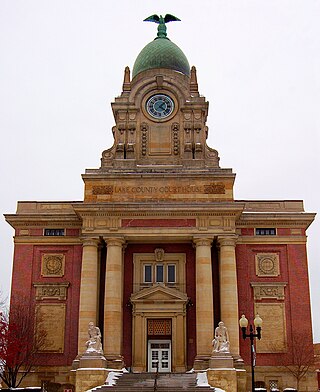
Lake County is a county in the U.S. state of Ohio. As of the 2020 census, the population was 232,603. Its county seat is Painesville, and its largest city is Mentor.

Geauga County is a county in the U.S. state of Ohio. As of the 2020 census, the population was 95,397. The county seat and largest city is Chardon.

Ashtabula County is the northeasternmost county in the U.S. state of Ohio. As of the 2020 census, the population was 97,574. The county seat is Jefferson, while its largest city is Ashtabula. The county was created in 1808 and later organized in 1811. The name Ashtabula derives from the Lenape language phrase ashte-pihële, which translates to 'always enough (fish) to go around, to be given away' and is a contraction of apchi ('always') + tepi ('enough') + hële. Ashtabula County is part of the Cleveland, OH Metropolitan Statistical Area.

Geneva is a city in northwestern Ashtabula County, Ohio, United States. The population was 5,924 at the 2020 census. It is part of the Cleveland metropolitan area, 44 miles (71 km) northeast of Cleveland. The area which would become Geneva was originally settled in 1805, and was incorporated as a city in 1958. It is named after Geneva, New York.

Burton is a village in Geauga County, Ohio, United States. The population was 1,407 at the 2020 census. It is part of the Cleveland metropolitan area. Burton is the location of Century Village, run by the Geauga Historical Society. The museum village is composed of 19th-century buildings moved there from other locations. Many special events are held there each year, as well as at the Geauga County Fairgrounds, also in Burton.

Chesterland is a census-designated place (CDP) in Geauga County, Ohio, United States. As of the 2020 census, the CDP had a population of 7,074.

Middlefield is a village in Geauga County, Ohio, United States. The population was 2,748 at the 2020 census. It is part of the Cleveland metropolitan area. Middlefield is known for being the center of the world's fourth largest Amish settlement, and its significant manufacturing base, which includes Gold Key Processing, Inc., Duncan Toys and KraftMaid. Because of its central location, home of the areas' public schools and prominent business and retail presence, Middlefield village is considered the hub community for Huntsburg, Parkman, and Middlefield Townships.

South Russell is a village in Geauga County, Ohio, United States. The population was 3,972 at the 2020 census. It is part of the Cleveland metropolitan area.
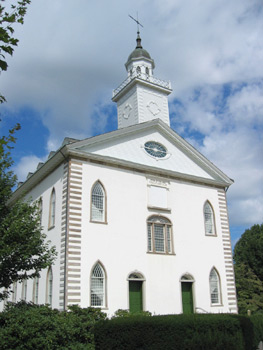
Kirtland is a city in Lake County, Ohio, United States. The population was 6,937 at the 2020 census. Kirtland is known for being the early headquarters of the Latter Day Saint movement from 1831 to 1837 and the site of the movement's first temple, the Kirtland Temple, completed in 1836. The Kirtland Temple and nearby Historic Kirtland Village are maintained as historic sites highlighting that era. The city is also the location for multiple parks in the Lake Metroparks system, as well as the Holden Arboretum.
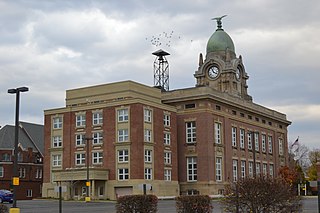
Painesville is a city in and the county seat of Lake County, Ohio, United States, located along the Grand River. It is a northeast suburb of Cleveland. Its population was 20,312 at the 2020 census. Painesville is included in the Greater Cleveland metropolitan area.
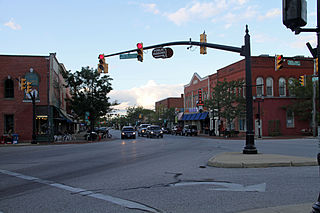
Willoughby is a city in Lake County, Ohio, United States, along the Chagrin River. The population was 23,959 at the time of the 2020 census. A suburb of Cleveland, it is part of the Cleveland metropolitan area.

Aurora is a city in northwestern Portage County, Ohio, United States. A suburb in between Akron and Cleveland, the population was 17,239 at the 2020 census. It is part of the Akron metropolitan area.

Hunting Valley is a village in Cuyahoga and Geauga counties in the U.S. state of Ohio. The population was 763 as of the 2020 census. An eastern suburb of Cleveland, it is part of the Cleveland metropolitan area. In 2000, Hunting Valley was ranked the 6th highest-income place in the United States. It was the 17th highest-income place in 2010, but still the wealthiest locale in Ohio.
Bainbridge is a census-designated place (CDP) in Bainbridge Township, Geauga County, Ohio, United States. As of the 2020 census, the CDP had a population of 9,242.

Munson Township is one of the sixteen townships of Geauga County, Ohio, United States. As of the 2020 census the population was 7,087.

Claridon Township is one of the sixteen townships of Geauga County, Ohio, United States. As of the 2020 census the population was 3,103, of whom 2,865 lived in the unincorporated portions of the township.

Chardon Township is one of the sixteen townships of Geauga County, Ohio, United States. As of the 2020 census the population was 4,494.
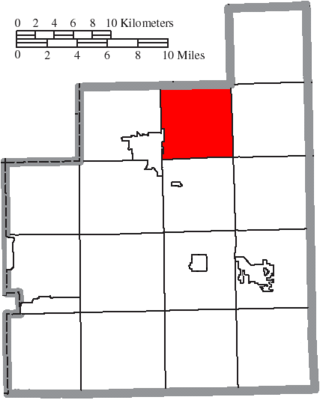
Hambden Township is one of the sixteen townships of Geauga County, Ohio, United States. As of the 2020 census the population was 4,676, up from 4,024 at the 2000 census.

Concord Township is one of the five townships of Lake County, Ohio, United States. As of the 2020 census, the population was 19,254. Lake County is part of the Cleveland-Elyria, OH Metropolitan Statistical Area.
Bass Lake is a census-designated place (CDP) in Geauga County, Ohio, United States, corresponding to the unincorporated community of West Bass Lake. The area was first listed as a CDP prior to the 2020 census.
























